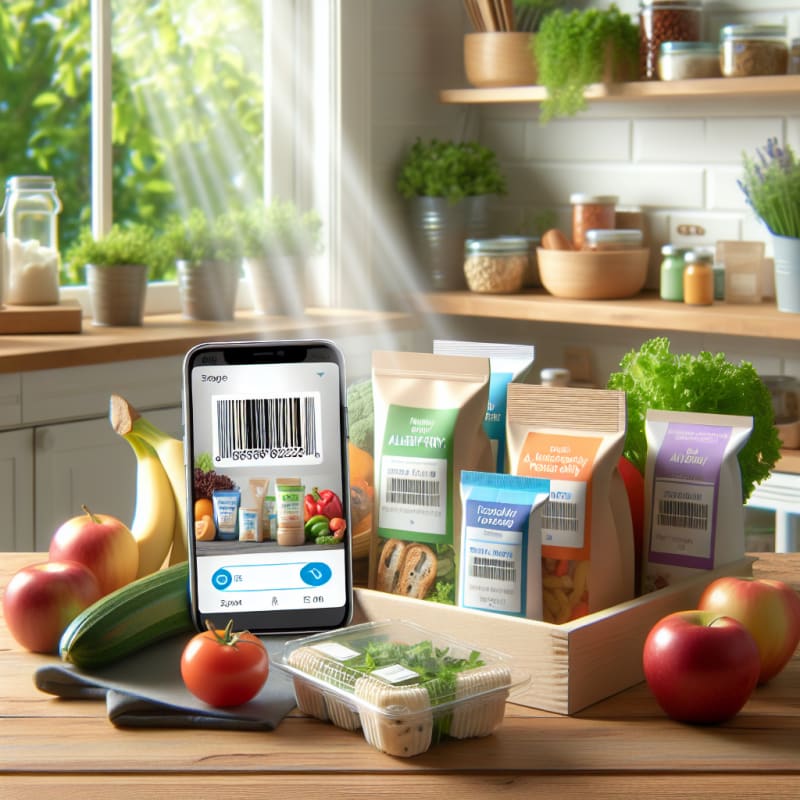Scan Your Food For Allergens – Here’s How
Category: Generic Scanners | Focus Keyword: scan your food for allergens – here’s how
Have you ever stood in a grocery aisle, squinting at a tiny label, wondering if that snack contains something that could make you sick? You’re not alone. As someone who’s lived with food allergies for years, I know the anxiety that comes with every bite. But what if you could scan your food for allergens—right there, instantly? In this confessional, I’ll share my journey, the science, and the technology that’s changing how we all approach food safety in 2025.
Why Scanning Your Food for Allergens Matters
Food allergies are more common than ever. According to the U.S. Food and Drug Administration (FDA), over 32 million Americans have food allergies, and reactions can range from mild discomfort to life-threatening anaphylaxis1. The European Food Safety Authority (EFSA) reports similar trends in Europe2.
- Hidden ingredients can lurk in processed foods.
- Cross-contamination is a real risk in manufacturing and restaurants.
- Labeling laws vary by country and aren’t always clear.
For people with allergies, celiac disease, or specific dietary preferences, every meal is a potential minefield. That’s why learning to scan your food for allergens – here’s how is more than a convenience—it’s a necessity.
What Does It Mean to “Scan” Your Food for Allergens?
“Scanning” your food isn’t just about reading labels. In 2025, it means using technology—like barcode scanners, smartphone apps, and even portable spectrometers—to analyze ingredients, detect hidden allergens, and make informed choices instantly.
| Method | How It Works | Best For |
|---|---|---|
| Barcode Scanning Apps | Scan product barcode, app checks ingredient database | Packaged foods, grocery shopping |
| Ingredient Recognition Apps | Photo or text scan of label, AI interprets allergens | Complex labels, international foods |
| Portable Allergen Sensors | Test a food sample for specific proteins (e.g., peanuts, gluten) | Dining out, homemade foods |
| Manual Label Reading | Read and interpret ingredient list yourself | All foods, but prone to human error |
How to Scan Your Food for Allergens – Here’s How (Step-by-Step)
-
Identify Your Allergens
Make a list of your known allergens (e.g., peanuts, gluten, dairy). The National Institutes of Health (NIH) recommends updating this list regularly with your doctor3. -
Choose Your Scanning Tool
Decide if you’ll use a barcode scanner app, ingredient recognition app, or a portable sensor. For me, the Food Scan Genius app has been a game-changer (more on that below). -
Scan the Product
Open your app, point your phone at the barcode or label, and let the AI do the work. Some apps let you take a photo of the ingredient list for instant analysis. -
Review Allergen Warnings
The app will highlight any allergens or cross-contamination risks. Always double-check if you’re unsure. -
Test When in Doubt
If you’re eating something homemade or from a restaurant, consider using a portable allergen sensor for extra peace of mind.
Pro tip: Always keep your scanning app updated to access the latest ingredient databases and allergen warnings.
My Confession: How Food Scan Genius Changed My Life
I used to dread eating out or trying new foods. The fear of hidden nuts or gluten was always there. But after I started using Food Scan Genius, everything changed. The app lets me scan a barcode or label, instantly flagging any ingredient I need to avoid—and even suggests safe alternatives.
“I finally feel safe trying new foods again. Food Scan Genius has my back, and I can’t recommend it enough to anyone with allergies or dietary preferences.”
– Jamie L., Food Scan Genius User
Ready to take control? Download Food Scan Genius now and experience the freedom of worry-free eating.
What Are the Top Food Scanning Apps in 2025?
The food scanning app market is booming, with several standout options:
- Food Scan Genius – AI-powered, customizable allergen profiles, global database.
- Spoonful – Focuses on FODMAP and gluten scanning, great for IBS and celiac users.
- Yuka – Analyzes nutrition and additives, highlights allergens.
- Allergy Amulet – Portable sensor for on-the-go allergen detection.
According to a 2024 CNN Health article, these apps are “empowering millions to take charge of their health and safety.”
How Do Barcode and Ingredient Scanning Apps Work?
Most apps use a combination of barcode scanning, Optical Character Recognition (OCR), and AI-powered ingredient analysis. Here’s how:
- Barcode Scan: The app reads the Universal Product Code (UPC) and pulls up the product’s ingredient list from a global database.
- Ingredient Analysis: AI algorithms scan the ingredient list for known allergens, cross-referencing your personal profile.
- Real-Time Alerts: If an allergen is detected, the app sends a warning and may suggest alternatives.
This technology is supported by advances in AI and NLP, making it possible to interpret complex ingredient lists—even in multiple languages. A New York Times report highlights how these apps are “bridging the gap between science and daily life.”
Are Portable Allergen Sensors Accurate?
Portable allergen sensors, like the Allergy Amulet, use biosensors to detect proteins from peanuts, gluten, and other common allergens. According to a 2023 PubMed study, these devices can be up to 95% accurate for certain allergens4. However, they’re not foolproof—always use them as an extra layer of protection, not a replacement for label reading or scanning.
What About Cross-Contamination?
Cross-contamination occurs when allergens are unintentionally transferred from one food to another. Even the best scanners can’t always detect trace amounts. That’s why apps like Food Scan Genius include manufacturer warnings and cross-contact alerts, helping you make safer choices.
- Look for “may contain” or “processed in a facility with…” statements.
- When in doubt, contact the manufacturer directly.
The Washington Post recently reported on the importance of clear cross-contamination labeling for allergy safety.
Who Should Use Food Scanning Technology?
While people with severe allergies benefit most, food scanning tools are also helpful for:
- Parents of children with allergies
- People with celiac disease or gluten sensitivity
- Vegans, vegetarians, and those with religious dietary restrictions
- Anyone curious about what’s really in their food
As awareness grows, more people are using these tools to avoid unwanted ingredients, additives, and even pesticides.
How to Install and Set Up a Food Scanning App
Ready to scan your food for allergens – here’s how to get started:
- Download the App: Visit the Food Scan Genius website or your device’s app store.
- Create Your Profile: Enter your allergens, dietary preferences, and any other restrictions.
- Start Scanning: Use your phone’s camera to scan barcodes or ingredient lists. The app will alert you instantly if there’s a risk.
Most apps are free or offer premium features for advanced scanning and international foods.
Frequently Asked Questions (FAQ)
- Can food scanning apps detect all allergens?
- Most apps cover the top 14 allergens, but always check the app’s database and scan manually if you have rare allergies.
- Are food scanning apps reliable?
- Yes, when used with updated databases and personal allergen profiles. Always double-check for new ingredients or brands.
- Do I still need to read food labels?
- Yes. Technology is a powerful tool, but human oversight is essential for safety.
- Can I use these apps for restaurant meals?
- Some apps provide restaurant menu scanning, but portable sensors are best for testing prepared foods.
- Is Food Scan Genius available worldwide?
- Yes, with global ingredient databases and multi-language support.
Raising the Larger Issue: Why Everyone Should Care
Even if you don’t have allergies, understanding what’s in your food is crucial. Food additives, preservatives, and hidden sugars can impact your health. Technology is making it easier for all of us to make informed choices—whether you’re managing allergies, following a diet, or just want to eat cleaner.
The rise of food scanning technology also raises questions about food transparency, labeling laws, and consumer rights. As BBC News reports, “Consumers are demanding more information—and companies are responding with smarter labels and digital tools.”
Conclusion: Take Control of Your Food, Your Health, Your Life
I used to feel powerless in the face of food allergies. But now, with the right technology, I can scan my food for allergens—instantly, confidently, and safely. Whether you use Food Scan Genius or another trusted app, you’re taking a bold step toward protecting yourself and your loved ones.
Don’t leave your health to chance. Embrace the power of food scanning technology and make every meal a safe, enjoyable experience. Install Food Scan Genius today—because you deserve to eat with confidence.





